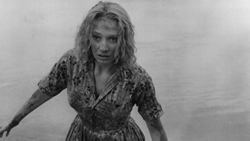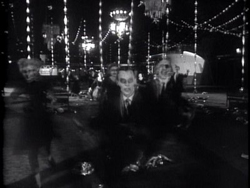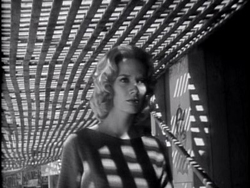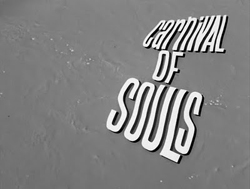Some of the easiest cultural influences to trace are the hardest cultural artifacts to track down. I’d heard of Carnival of Souls most of my life, but didn’t see it until five days before Halloween, 2012. The first-time rewatch was staged in the fittingly phantasmal setting of the Lowe’s Jersey, a shadowy movie-cathedral from 1929 in somewhat better shape than the ghostly Victorian pavilion that Carnival’s heroine is drawn to. That once-merry shell is found in the middle of the Utah desert, and the movie had to cross a similar limbo to arrive in the graces of several generations of filmmakers and enthusiasts.
A low-budget moody thriller released independently in 1962, its influence on George A. Romero and M. Night Shyamalan is clear and not uncommonly remarked. The impact it may have had—or the subconscious lines it travels along—may be wider than that. Late-century arthouse-pastiche perfume and fashion advertising owes as much to the subaquatic pace and surreal slo-mo revelers of this film as it does to any Fellini scenario, and I can’t help wondering if Toni Morrison saw a print at some indelible age.
 The film begins when a young woman seemingly perishes in a car run off a narrow country bridge, emerging mysteriously days later in a drenched ghostly dress from the middle of the river where local officials are fruitlessly dredging. It’s an eerie amniotic image, a full-grown birth from what you were into what trauma makes you, that has most in common with Beloved two decades later. We’re pretty sure we’re watching a ghost story but, as in reading Beloved, don’t know quite how.
The film begins when a young woman seemingly perishes in a car run off a narrow country bridge, emerging mysteriously days later in a drenched ghostly dress from the middle of the river where local officials are fruitlessly dredging. It’s an eerie amniotic image, a full-grown birth from what you were into what trauma makes you, that has most in common with Beloved two decades later. We’re pretty sure we’re watching a ghost story but, as in reading Beloved, don’t know quite how.
The apparent survivor, Mary, relocates to Utah, to take a job as a church organist—a profession tailored to performing the soundtrack to her own spiritual drift—amidst recurrent episodes where no one seems to hear or notice her, and a public collapse after which a passing doctor (and amateur psychologist) tries to counsel her.
 Hallucinating ghoulish intruders who mostly just stand in the distance beyond what anyone else can see, and fascinated by a long-deserted local amusement complex, she comes to a Sixth Sense-like end which I won’t reveal for others who have waited longer than me to see this film, but which surprises no one. But the plot is not the point; chilly outpost atmosphere and the inner geography of a troubled soul are what the movie means.
Hallucinating ghoulish intruders who mostly just stand in the distance beyond what anyone else can see, and fascinated by a long-deserted local amusement complex, she comes to a Sixth Sense-like end which I won’t reveal for others who have waited longer than me to see this film, but which surprises no one. But the plot is not the point; chilly outpost atmosphere and the inner geography of a troubled soul are what the movie means.
First-time (and only-time) feature director Herk Harvey has a photojournalist’s eye for compelling compositions, haunting found settings, ephemeral but substantial geometries of light and shadow, and subtle, unsettling effects. The rhythm of depression is well recorded in Mary’s wavering disconnections from the world, in a way more skillful than the would-be psychoanalyst’s. And most remarkable, the film’s woman protagonist is a true point-of-view character we identify with, not the target of misfortunes we exult in escaping ourselves.
 No other midcentury movies—not Hitchcock’s—portrayed a female lead this empathetically rather than as a damsel without a rescuer, and it’s a revelation to see the progression of her un-demonized decisions—independent career, disinterest in relationships, resistance to psychiatric labeling—and the procession of clue-deficient but not cardboard males she interacts with.
No other midcentury movies—not Hitchcock’s—portrayed a female lead this empathetically rather than as a damsel without a rescuer, and it’s a revelation to see the progression of her un-demonized decisions—independent career, disinterest in relationships, resistance to psychiatric labeling—and the procession of clue-deficient but not cardboard males she interacts with.
When they convene at the end, one pillar each of masculine authority—well-meaning doctor, baffled but concerned reverend, local police chief—in the desolate surroundings of the deserted amusement park, with Mary nowhere to be seen again, it’s as if she’s left a world that wasn’t yet ready for her; in which, despite the sensitive filmmakers’ best efforts, she can’t yet comfortably exist. But the lesson of her presence lingers, and she remains worth looking for.
Adam McGovern’s dad taught comics to college classes and served as a project manager in the U.S. government’s UFO-investigating operation in the 1950s; the rest is made up. There is material proof, however, that Adam has written comicbooks for Image (The Next issue Project), Trip City.com, the acclaimed indie broadsheet POOD, and GG Studios, and blogs regularly at HiLoBrow.com and ComicCritique. He lectures on pop culture in forums like The NY Comics & Picture-story Symposium and interviewed time-traveling author Glen Gold at the back of his novel Sunnyside (and at this link). Adam proofreads graphic novels for First Second, has official dabblings in produced plays, recorded songs and published poetry, and is available for commitment ceremonies and intergalactic resistance movements. His future self will be back to correct egregious typos and word substitutions in this bio any minute now. And then he’ll kill Hitler, he promises.










